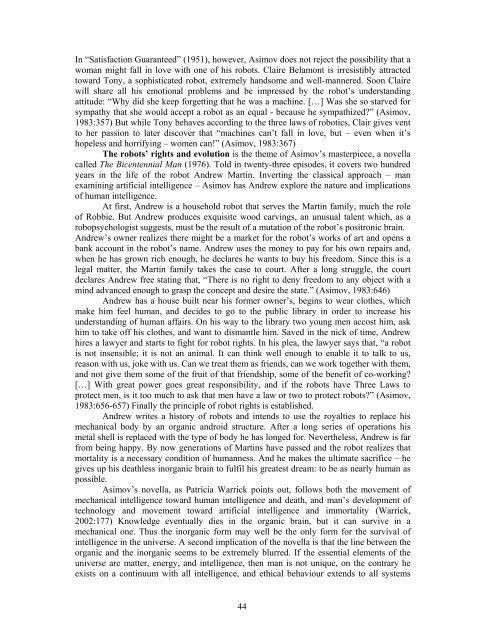PDF. - full text
PDF. - full text
PDF. - full text
Create successful ePaper yourself
Turn your PDF publications into a flip-book with our unique Google optimized e-Paper software.
In “Satisfaction Guaranteed” (1951), however, Asimov does not reject the possibility that a<br />
woman might fall in love with one of his robots. Claire Belamont is irresistibly attracted<br />
toward Tony, a sophisticated robot, extremely handsome and well-mannered. Soon Claire<br />
will share all his emotional problems and be impressed by the robot’s understanding<br />
attitude: “Why did she keep forgetting that he was a machine. […] Was she so starved for<br />
sympathy that she would accept a robot as an equal - because he sympathized?” (Asimov,<br />
1983:357) But while Tony behaves according to the three laws of robotics, Clair gives vent<br />
to her passion to later discover that “machines can’t fall in love, but – even when it’s<br />
hopeless and horrifying – women can!” (Asimov, 1983:367)<br />
The robots’ rights and evolution is the theme of Asimov’s masterpiece, a novella<br />
called The Bicentennial Man (1976). Told in twenty-three episodes, it covers two hundred<br />
years in the life of the robot Andrew Martin. Inverting the classical approach – man<br />
examining artificial intelligence – Asimov has Andrew explore the nature and implications<br />
of human intelligence.<br />
At first, Andrew is a household robot that serves the Martin family, much the role<br />
of Robbie. But Andrew produces exquisite wood carvings, an unusual talent which, as a<br />
robopsychologist suggests, must be the result of a mutation of the robot’s positronic brain.<br />
Andrew’s owner realizes there might be a market for the robot’s works of art and opens a<br />
bank account in the robot’s name. Andrew uses the money to pay for his own repairs and,<br />
when he has grown rich enough, he declares he wants to buy his freedom. Since this is a<br />
legal matter, the Martin family takes the case to court. After a long struggle, the court<br />
declares Andrew free stating that, “There is no right to deny freedom to any object with a<br />
mind advanced enough to grasp the concept and desire the state.” (Asimov, 1983:646)<br />
Andrew has a house built near his former owner’s, begins to wear clothes, which<br />
make him feel human, and decides to go to the public library in order to increase his<br />
understanding of human affairs. On his way to the library two young men accost him, ask<br />
him to take off his clothes, and want to dismantle him. Saved in the nick of time, Andrew<br />
hires a lawyer and starts to fight for robot rights. In his plea, the lawyer says that, “a robot<br />
is not insensible; it is not an animal. It can think well enough to enable it to talk to us,<br />
reason with us, joke with us. Can we treat them as friends, can we work together with them,<br />
and not give them some of the fruit of that friendship, some of the benefit of co-working?<br />
[…] With great power goes great responsibility, and if the robots have Three Laws to<br />
protect men, is it too much to ask that men have a law or two to protect robots?” (Asimov,<br />
1983:656-657) Finally the principle of robot rights is established.<br />
Andrew writes a history of robots and intends to use the royalties to replace his<br />
mechanical body by an organic android structure. After a long series of operations his<br />
metal shell is replaced with the type of body he has longed for. Nevertheless, Andrew is far<br />
from being happy. By now generations of Martins have passed and the robot realizes that<br />
mortality is a necessary condition of humanness. And he makes the ultimate sacrifice – he<br />
gives up his deathless inorganic brain to fulfil his greatest dream: to be as nearly human as<br />
possible.<br />
Asimov’s novella, as Patricia Warrick points out, follows both the movement of<br />
mechanical intelligence toward human intelligence and death, and man’s development of<br />
technology and movement toward artificial intelligence and immortality (Warrick,<br />
2002:177) Knowledge eventually dies in the organic brain, but it can survive in a<br />
mechanical one. Thus the inorganic form may well be the only form for the survival of<br />
intelligence in the universe. A second implication of the novella is that the line between the<br />
organic and the inorganic seems to be extremely blurred. If the essential elements of the<br />
universe are matter, energy, and intelligence, then man is not unique, on the contrary he<br />
exists on a continuum with all intelligence, and ethical behaviour extends to all systems<br />
44












